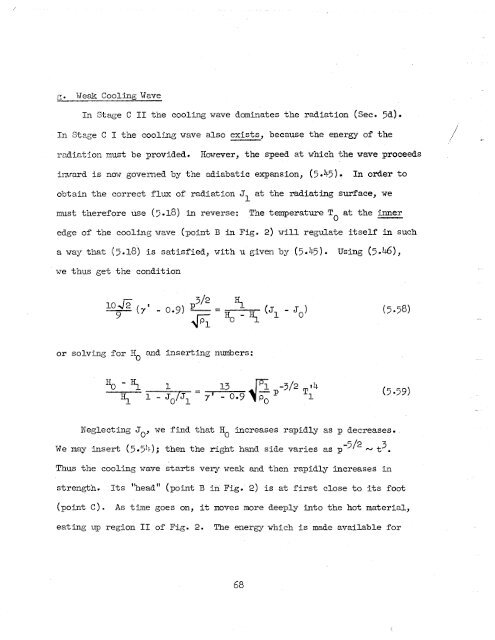Theory of the Fireball
Theory of the Fireball
Theory of the Fireball
You also want an ePaper? Increase the reach of your titles
YUMPU automatically turns print PDFs into web optimized ePapers that Google loves.
G. We& Cool-ing Wave<br />
In Stage C I1 tne cooling wave dominates <strong>the</strong> radiation (Sec. 5d) .<br />
In Stage C I <strong>the</strong> cooling mme also exists, because <strong>the</strong> energy <strong>of</strong> <strong>the</strong><br />
radiztj-on must be provided. Hovever, <strong>the</strong> speed at wnich <strong>the</strong> trave proceeds<br />
inward is nov governed by tne adiabatic expansion, (3 .LO) a In order to<br />
obtain <strong>the</strong> correct flux <strong>of</strong> radiation J<br />
1<br />
at <strong>the</strong> radiating surface, we<br />
must <strong>the</strong>refore use (5.18) in reverse: Tine temperature T at <strong>the</strong> inner<br />
0<br />
edge <strong>of</strong> Cne cooling 77ave (point B in Fig. 2) wil regulate itself in such<br />
a vay that (5*18) is satisfied, with u given by (5.lJr5). Using (5.461,<br />
we thus get <strong>the</strong> condition<br />
or solving for To and inserting numbers:<br />
13<br />
y' - 0.9<br />
P -3/2 Ti4 (5 059)<br />
PlTeglecting Jo, we find that Ho increases rapidly as p decreases.<br />
We may insert (5.31!-); <strong>the</strong>n <strong>the</strong> right nand side varies as p<br />
-5/2 - t3*<br />
Thus <strong>the</strong> cooling wave starts very weak and <strong>the</strong>n rapidly increases in<br />
strengtn. Its "head" (point B in Fig.' 2) is at first close to its foot<br />
(point C). As time goes on, it moves more deeply into t'ne hot material,<br />
eating up region I1 <strong>of</strong> Fig. 2. The energy which is made available for<br />
68
















